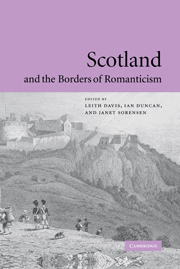Book contents
- Frontmatter
- Contents
- List of contributors
- Acknowledgments
- Introduction
- 1 Coleridge, Hume, and the chains of the Romantic imagination
- 2 The pathos of abstraction: Adam Smith, Ossian, and Samuel Johnson
- 3 Antiquarianism, the Scottish Science of Man, and the emergence of modern disciplinarity
- 4 Melancholy, memory, and the “narrative situation” of history in post-Enlightenment Scotland
- 5 Scott, the Scottish Enlightenment, and Romantic Orientalism
- 6 Walter Scott's Romantic postmodernity
- 7 Putting down the Rising
- 8 Joanna Baillie stages the nation
- 9 William Wordsworth and William Cobbett: Scotch travel and British reform
- 10 Burns's topographies
- 11 At “sang about”: Scottish song and the challenge to British culture
- 12 Romantic spinstrelsy: Anne Bannerman and the sexual politics of the ballad
- 13 “The fause nourice sang”: childhood, child murder, and the formalism of the Scottish ballad revival
- Index
Introduction
Published online by Cambridge University Press: 22 September 2009
- Frontmatter
- Contents
- List of contributors
- Acknowledgments
- Introduction
- 1 Coleridge, Hume, and the chains of the Romantic imagination
- 2 The pathos of abstraction: Adam Smith, Ossian, and Samuel Johnson
- 3 Antiquarianism, the Scottish Science of Man, and the emergence of modern disciplinarity
- 4 Melancholy, memory, and the “narrative situation” of history in post-Enlightenment Scotland
- 5 Scott, the Scottish Enlightenment, and Romantic Orientalism
- 6 Walter Scott's Romantic postmodernity
- 7 Putting down the Rising
- 8 Joanna Baillie stages the nation
- 9 William Wordsworth and William Cobbett: Scotch travel and British reform
- 10 Burns's topographies
- 11 At “sang about”: Scottish song and the challenge to British culture
- 12 Romantic spinstrelsy: Anne Bannerman and the sexual politics of the ballad
- 13 “The fause nourice sang”: childhood, child murder, and the formalism of the Scottish ballad revival
- Index
Summary
SCOTLAND IN ROMANTICISM
“What a hobbling pace the Scottish Pegasus seems to have adopted in these days,” grumbled William Wordsworth in a letter to R. P. Gillies (February 14, 1815). Wordsworth condemns the “insupportable slovenliness and neglect of syntax and grammar, by which James Hogg's writings are disfigured”; such solecisms may be “excusable in [Hogg] from his education, but Walter Scott knows, and ought to do, better.” Both poets can be summarily dismissed: “They neither of them write a language which has any pretension to be called English.” Wordsworth's complaint cuts across distinct if overlapping conceptions of the institutional framework of British Romantic literature: as a market, in which Scottish writing enjoys a notable success, and as a canon, from which it must be purged – on the grounds of a national deficiency, a linguistic unfitness “to be called English.”
Wordsworth's verdict has proven remarkably durable. Modern literary criticism in Great Britain and North America adopted the view of Romanticism as a unitary phenomenon, the agon of a mighty handful of lyric poets with a Kantian (later Heideggerian) problematic of the transcendental imagination. Some Romanticisms are more Romantic than others: some are the real thing, while others are premature or belated, or simply false – anachronistic or fraudulent simulacra. British Romanticism is English, from Blake and Lyrical Ballads in the 1790s to Keats, Shelley, and Byron (cut off from his own Scottish roots), prematurely dead in the early 1820s.
- Type
- Chapter
- Information
- Scotland and the Borders of Romanticism , pp. 1 - 19Publisher: Cambridge University PressPrint publication year: 2004
- 4
- Cited by



